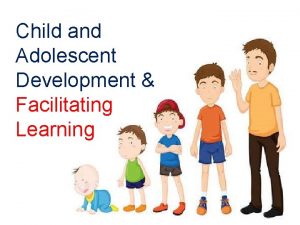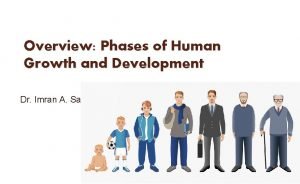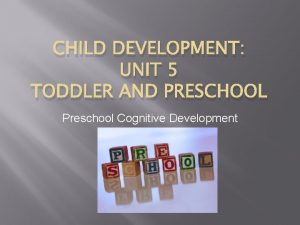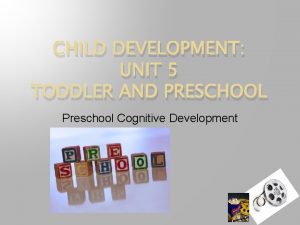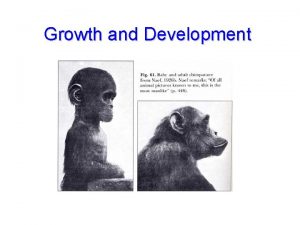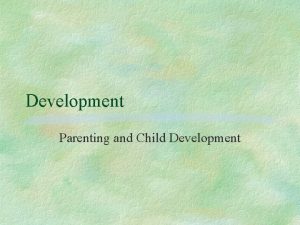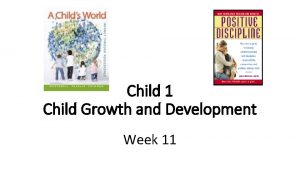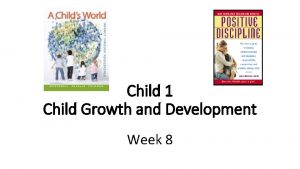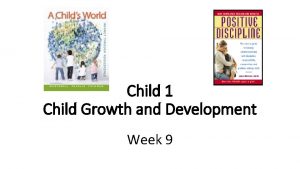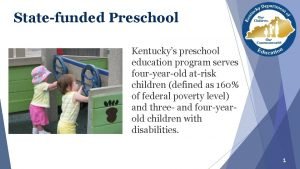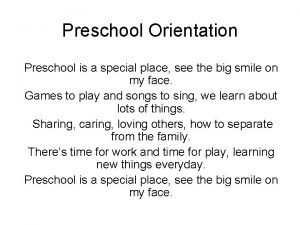Growth and Development of the Preschool Child 3



















- Slides: 19

Growth and Development of the Preschool Child: 3 to 6 Years Chapter 20 Copyright © 2008 Wolters Kluwer Health | Lippincott Williams & Wilkins

Physical Development of the Preschool Child • Slowed growth rate • Changes in dentition • Changes in visual development • Changes in skeletal growth, especially in the feet and legs Copyright © 2008 Wolters Kluwer Health | Lippincott Williams & Wilkins

Growth Rate of the Preschooler • Gains about 3 to 5 lbs each year (1. 4 to 2. 3 kg) • Grows about 2. 5 inches (6. 3 cm) • Gross and fine motor skills continue to develop rapidly • Balance improves • Confidence emerges to try new activities • By age 5, can throw and catch a ball well, climb effectively, and ride a bicycle Copyright © 2008 Wolters Kluwer Health | Lippincott Williams & Wilkins

Dentition in the Preschooler • By 6 years: child’s skull is 90% of its adult size • Beginning of preschool stage: deciduous teeth have completely emerged • End of preschool stage: permanent teeth begin to be replaced by deciduous teeth – Age varies with individual children and with ethnic and economic groups – The central incisors are usually the first to go Copyright © 2008 Wolters Kluwer Health | Lippincott Williams & Wilkins

Visual Development of the Preschooler • Visual development is still immature at age 3 • Eye–hand coordination is good • Judgment of distances generally is faulty • Vision should be checked to screen for amblyopia • Usually by age 6 the child has achieved 20/20 vision • Mature depth perception may not occur in some children until 8 to 10 years of age Copyright © 2008 Wolters Kluwer Health | Lippincott Williams & Wilkins

Characteristics of the Psychosocial Development of the Preschooler • Rapid language development • Imagination • Sexual and social development • Variety of types of play Copyright © 2008 Wolters Kluwer Health | Lippincott Williams & Wilkins

Factors Affecting Language Development in the Preschooler • Hearing impairment or other physical problem • Lack of stimulation • Overprotection • Lack of parental interest or rejection by parents Copyright © 2008 Wolters Kluwer Health | Lippincott Williams & Wilkins

Development of Imagination in the Preschooler • Makes it difficult to separate fantasy from reality • Makes preschoolers good audiences for storytelling, simple plays, and television • May lead to imaginary playmates who are very real to them • Often leads to a fear of the dark, nightmares, and sleep problems Copyright © 2008 Wolters Kluwer Health | Lippincott Williams & Wilkins

Development of Sexuality in the Preschooler • They are acutely aware of their sexuality, including sexual roles and organs • They generally develop a strong emotional attachment to the parent of the opposite sex • Curiosity about sex may make parents uncomfortable and evoke negative responses • The caregiver should teach responsible sexual information • The caregiver should teach the child “good touch” and “bad touch” Copyright © 2008 Wolters Kluwer Health | Lippincott Williams & Wilkins

Types of Preschooler Play • Dramatic • Cooperative • Associative • Parallel • Solitary independent • Onlooker • Unoccupied behavior Copyright © 2008 Wolters Kluwer Health | Lippincott Williams & Wilkins

Role of Discipline for the Preschooler • Teach responsibility and inner control • Agree to limits and discipline measures – Spanking removes the responsibility from the child – Taking away a privilege is much more effective • Keep the period brief – The child’s concept of time is not clear Copyright © 2008 Wolters Kluwer Health | Lippincott Williams & Wilkins

Goals of Head Start Programs • Broaden child’s horizons through varied experiences • Increase child’s understanding of his or her world • Teach motor, cognitive, self-help, and language skills • Provide counseling and referral services • Prepare child to enter school • Prepare child to compete successfully with peers Copyright © 2008 Wolters Kluwer Health | Lippincott Williams & Wilkins

Nutrition for the Preschooler • Does not need large quantities of food • Protein needs continue to remain high for muscle growth • Appetite is erratic • Portions are smaller than adult-sized portions • Frequent, small meals with snacks in between best accepted Copyright © 2008 Wolters Kluwer Health | Lippincott Williams & Wilkins

Health Promotion and Maintenance for the Preschooler • Booster vaccinations – Given between 4 and 6 years of age • Annual health examination – Monitors the child’s growth and development – Screens for health problems Copyright © 2008 Wolters Kluwer Health | Lippincott Williams & Wilkins

Recommended Screening Procedures for the Preschooler • Urinalysis • Hematocrit • Lead level • Tuberculin skin testing • Denver Developmental Screening Test Copyright © 2008 Wolters Kluwer Health | Lippincott Williams & Wilkins

Topics for Family Teaching • Bathing • Dental care • Dressing • Toileting • Sleep needs • Accident prevention • Infection prevention Copyright © 2008 Wolters Kluwer Health | Lippincott Williams & Wilkins

Topics of Teaching to Prevent Accidents in Preschoolers • Seat belt use • Wearing bicycle safety helmets • Practicing street safety • Stranger danger • Fire drills • Swimming safety Copyright © 2008 Wolters Kluwer Health | Lippincott Williams & Wilkins

Topics of Teaching to Prevent Infections in Preschoolers • Covering mouth when coughing or sneezing • Disposing of tissues properly • Correctly wiping after bowel movements • Good handwashing • Not sharing cups, utensils, food, or toothbrushes Copyright © 2008 Wolters Kluwer Health | Lippincott Williams & Wilkins

Nursing Care for the Preschooler in a Health Care Facility • Use play to act out anxieties and learn what to expect from the hospital situation • Do not use a rectal thermometer • Do not scold a child for reverting to bedwetting • Follow home routines as closely as possible • Carefully explain all procedures to the child • Provide play material Copyright © 2008 Wolters Kluwer Health | Lippincott Williams & Wilkins
 Preschool moral development
Preschool moral development Plant growth index
Plant growth index Root hair structure
Root hair structure Primary growth and secondary growth in plants
Primary growth and secondary growth in plants Vascular ray
Vascular ray Carothers equation
Carothers equation Geometric growth graph
Geometric growth graph Neoclassical growth theory vs. endogenous growth theory
Neoclassical growth theory vs. endogenous growth theory Difference between organic and inorganic growth
Difference between organic and inorganic growth Scaffold and fade-away technique
Scaffold and fade-away technique Murdoch pie chart
Murdoch pie chart Internally programmed growth of a child
Internally programmed growth of a child Internally programmed growth of a child
Internally programmed growth of a child Left child right sibling
Left child right sibling Stages of human growth and development pictures
Stages of human growth and development pictures Theory of growth and development
Theory of growth and development Stages of human growth and development pictures
Stages of human growth and development pictures Social development in late childhood
Social development in late childhood Pretest: growth, development, and sexuality
Pretest: growth, development, and sexuality Growth development maturation
Growth development maturation









